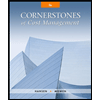
1.
Introduction:
Step-down method: The
Allocation of the service department’s cost to the consuming department and the predetermined overhead rates in the operating department.
2.
Introduction:
Direct method: Under the direct method, the overhead costs incurred by the supporting department are directly allocated to the operating department.
Allocation of the service department’s cost to the consuming department using the direct method and the predetermined overhead rate.
3.
a.
Step-down method: The overhead costs of supporting incurred by the supporting department are allocated to other supporting departments and also the operating department based on the allocation base.
The amount of overhead cost for the job using overhead rates computed in parts 1 and 2.
3.
b.
Step-down method: The overhead costs of supporting incurred by the supporting department are allocated to other supporting departments and also the operating department based on the allocation base.
The reason the step-down method is a better base for computing the predetermined rates than the direct method.
Want to see the full answer?
Check out a sample textbook solution
Chapter 5 Solutions
MANAGERIAL ACCOUNTING LL W/ CONNECT
- I need guidance in solving this financial accounting problem using standard procedures.arrow_forwardI am trying to find the accurate solution to this general accounting problem with appropriate explanations.arrow_forwardCan you help me solve this general accounting problem using the correct accounting process?arrow_forward
- How can I solve this financial accounting problem using the appropriate financial process?arrow_forwardPlease provide the accurate answer to this general accounting problem using valid techniquesarrow_forwardI need help with this general accounting question using the proper accounting approach.arrow_forward
- Can you explain the correct methodology to solve this general accounting problem?arrow_forwardDetermine the amount of the Earned Income Credit in each of the following cases. Assume that the person or persons are eligible to take the credit. Calculate the credit using the formulas. A single person with earned income of $ 7 , 8 5 4 and no qualifying children. A single person with earned income of $ 2 7 , 5 0 0 and two qualifying children. A married couple filing jointly with earned income of $ 3 4 , 1 9 0 and one qualifying child.arrow_forwardPlease help me solve this general accounting question using the right accounting principles.arrow_forward
- Assets Martinez Company Comparative Balance Sheets December 31 2025 2024 Cash $91,000 $52,000 Accounts receivable 52,000 36,400 Inventory 72,800 52,000 Property, plant, and equipment 156,000 202,800 Accumulated depreciation Total (83,200) [62,400) $288,600 $290,800 Liabilities and Stockholders' Equity Accounts payable $49,400 $ 39,000 Income taxes payable 18,200 20,800 Bonds payable 44,200 85,800 Common stock 46,900 36,400 Retained earnings 130,000 98,800 Total $288,600 $280,800 Martinez Company Income Statement For the Year Ended December 31, 2025 Sales revenue $629,200 Cost of goods sold 455,000 Gross profit 174,200 Selling expenses $46,800 Administrative expenses 15,600 62,400 Income from operations 111,800 Interest expense 7,800 Income before income taxes 104,000 Income tax expense 20,800 Net income $83,200 Additional data: 1. Depreciation expense was $45,500. 2. Dividends declared and paid were $52,000. 3. During the year, equipment was sold for $22,100 cash. This equipment…arrow_forwardagree or disagree with post The Stockholders' Equity section of a corporate balance sheet fundamentally differs from that of a single-owner business due to the inherent structure of a corporation versus a sole proprietorship. In a single-owner business, you'll usually see a single "Owner's Equity" account, which reflects the owner's investment, withdrawals, and accumulated profits or losses. Conversely, a corporation's Stockholders' Equity is more intricate, reflecting the contributions of multiple owners (stockholders) and the legal framework governing corporate capital. It's divided into contributed capital, which includes common and preferred stock, and retained earnings, which represents accumulated profits not yet distributed as dividends. Additionally, corporations may have accounts like "Additional Paid-in Capital" to capture amounts received above the par value of stock, and "Treasury Stock" to account for shares repurchased by the company. This detailed breakdown highlights…arrow_forwardEast Georgia Community Hospital enters into a contract to provide $15,000 of elective medical care to a patient. After a review of the patient's ability and intent to pay, the hospital does not expect to collect the full contract price of $15,000. However, the hospital occasionally performs "discounted" procedures to members of the community to enhance its standing in the local area. While the hospital invoiced the customer for the full amount of the services, it only expects to collect $10,000. What amount of revenue should the hospital recognize?arrow_forward
 Managerial Accounting: The Cornerstone of Busines...AccountingISBN:9781337115773Author:Maryanne M. Mowen, Don R. Hansen, Dan L. HeitgerPublisher:Cengage Learning
Managerial Accounting: The Cornerstone of Busines...AccountingISBN:9781337115773Author:Maryanne M. Mowen, Don R. Hansen, Dan L. HeitgerPublisher:Cengage Learning Cornerstones of Cost Management (Cornerstones Ser...AccountingISBN:9781305970663Author:Don R. Hansen, Maryanne M. MowenPublisher:Cengage Learning
Cornerstones of Cost Management (Cornerstones Ser...AccountingISBN:9781305970663Author:Don R. Hansen, Maryanne M. MowenPublisher:Cengage Learning Financial And Managerial AccountingAccountingISBN:9781337902663Author:WARREN, Carl S.Publisher:Cengage Learning,
Financial And Managerial AccountingAccountingISBN:9781337902663Author:WARREN, Carl S.Publisher:Cengage Learning, Managerial AccountingAccountingISBN:9781337912020Author:Carl Warren, Ph.d. Cma William B. TaylerPublisher:South-Western College Pub
Managerial AccountingAccountingISBN:9781337912020Author:Carl Warren, Ph.d. Cma William B. TaylerPublisher:South-Western College Pub Principles of Cost AccountingAccountingISBN:9781305087408Author:Edward J. Vanderbeck, Maria R. MitchellPublisher:Cengage Learning
Principles of Cost AccountingAccountingISBN:9781305087408Author:Edward J. Vanderbeck, Maria R. MitchellPublisher:Cengage Learning




